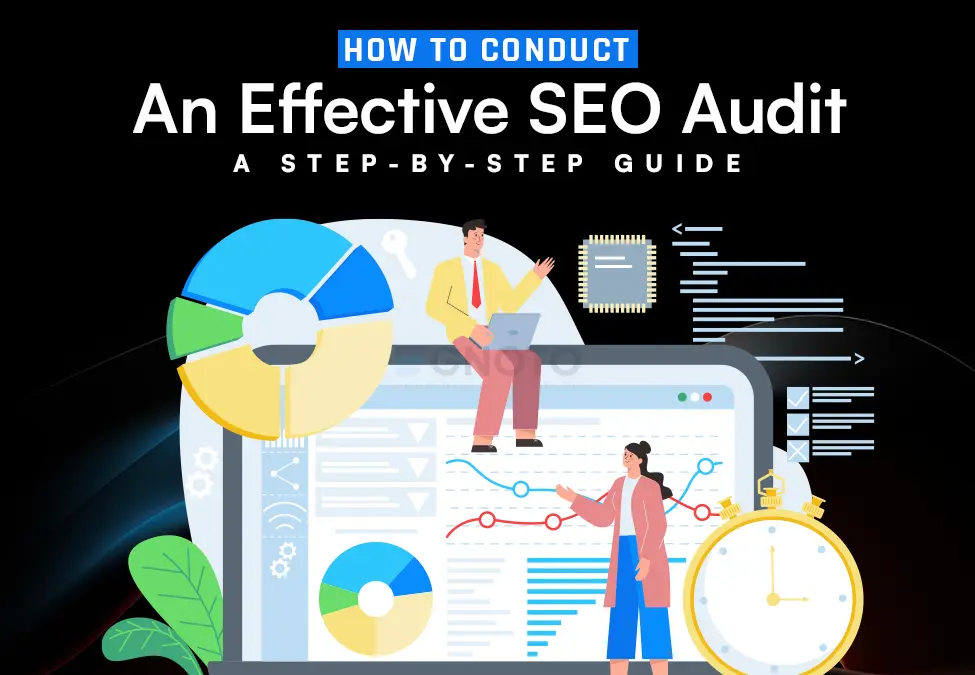SEO audit is like a health check-up of your website to perform impeccably. Just as humans can’t work effectively with improper health, a website can’t help you increase your business visibility, bring more traffic, and rank your blogs without an SEO audit.
It ensures that your website is ready to compete with competitors or not. SEO audit finds hidden issues, boosts ranking, and optimizes the site’s overall performance. Since over 60% of online experiences begin with a search engine (brightedge), your website should be ready not to lose this traffic.
Additionally, if you think SEO will remain irrelevant amid AI-generated content and tools, let me tell you that Google controls 90% of global search engine traffic (sparktoro). So, as long as Google remains the dominating search engine, SEO audits will remain vital.
In this blog, we will present you with effective SEO audit steps that you can implement easily to boost your website’s performance. Let’s get started!
What Is SEO Audit?
SEO audit is a practice performed on a website to improve its performance. Several things are considered for an accurate audit of the website. You can know the status of your website in the search engine rankings.
If your website is not ranking on Google SERPs, it means you need to optimize its search engine ranking and improve its health.
Top 5 Benefits of SEO Audit
Before moving ahead to find SEO audit steps, learn why they are crucial for your website. So, here are the top 5 benefits of SEO audit.
Identifies Issues in the Website:
When you start an SEO audit, you first see the issues on the website. SEO audit uncovers the technical issues and areas for improvement. You can identify crawling issues, duplicate content, meta tag deficiencies, and many other issues by just doing SEO audit.
Improves Website Performance:
SEO audit is all about improving website performance and ranking on Google search results. As you read, an SEO audit identifies issues in the site; you can resolve these issues effectively and improve site performance. It includes fixing errors, page load speed, broken links, and responsiveness issues. It all leads to improving the website’s performance.
Increases Visibility of Website:
The site’s visibility plays a crucial role in effective business growth. Lower site visibility leads to slower business reach. Since 3.5 billion searches happen on Google daily (internetlivestats), you can’t afford lousy visibility as it can result in a huge loss. SEO audit eliminates this problem and brings your business to its customers.
Enhanced User Experience:
An SEO audit makes your website easy to navigate, leading to more traffic. It also frees the site from technical glitches and optimizes it for different platforms. Moreover, the website’s faster loading time also enhances the user experience. Users only wait for 1-2 seconds to let your website load. So, poor website performance can cost you badly.
Provides Strategic Insights:
When you perform an SEO audit, you see the website’s strengths, weaknesses, and opportunities. You can get valuable insights into the website’s performance from different perspectives. It enables you to make informed decisions about the SEO strategies. You can know which SEO strategies are working well on your website and which ones are not with the help of an SEO audit. Moreover, strategic insights help to make better planning to improve the site’s visibility.
Easy and Effective Steps to Conduct SEO Audit
Today, most businesses have come online, and new ones are beginning their journey from the online market. Strong SEO audits are integral for the effective growth of any business since every business has a site these days.
Besides that, the existence of a website and proper SEO play crucial roles in marketing. HubSpot says SEO leads have a 14% close rate, while outbound leads have only 1%. Therefore, effective steps for SEO audits are crucial.
According to Statista, here are the popular search engine optimization strategies.
Scroll down to explore each point in great detail so you can implement them for your website SEO audit.
- Check the Website Structure:
Why check the website structure?
If your website structure is proper, Google crawler or bot and users can navigate your website pages and find information easily.
How to check the website structure?
First, check the site’s hierarchy for products, services, and pags. They should be in a logical sequence according to your customers’ search patterns. Ensure the site has intuitive designs and menus, making the journey of customers and crawlers easy on your site. It would be better to focus on SEO from the very first day you start developing your website instead of correcting it later.
- Assess the Website Health:
Why assess the website’s health?
Work on its overall performance once you have structured the website according to search engine optimization. Assess its health, which means its performance on the SERPs. Find out the reasons behind slow-loading pages, as they can lead to higher bounce rates.
How to assess the website’s health?
You can quickly assess the site’s health using tools like Google PageSpeed Insights, Wc3 link checker, Ahref, Google Trends, Screaming Frog, and Google Analytics. These tools help to check broken links, page load speed, mobile responsiveness, keyword ranking, on-page SEO, technical SEO, and other factors that affect the website’s health.
- Check the Duplicate Versions of Your Site:
Why check the duplicate versions of your site?
You should check for duplicate versions of your site to avoid confusing search engines. Duplicate websites also affect the authenticity of your online existence and can divert your traffic, eventually harming ranking.
How to check a duplicate version of your site?
You can use tools like Screaming Frogs and Copyscape to find duplicate site versions and take action accordingly. These tools identify duplicate URLs (HTTP vs. HTTPS, WWW, and non-WWW versions) and duplicate content. Use canonical tags to tell the crawler which are the original pages.
- Correct the Technical SEO:
Why check the site’s technical SEO?
Where will you drive traffic if your website is poorly indexed and designed? A proper site map, links, and mobile responsiveness affect the user and crawler’s experience, ultimately affecting ranking.
How to check the site’s technical SEO?
The first step in this process is selecting the right tools. Now, make a checklist with the points you will have to cover. Assess the site’s issues, analyze the crawl report, and review the Google Search Console reports. You can use Semrush and Deep Crawl for technical SEO audits.
- Evaluate On-page SEO:
Why evaluate on-page SEO?
Your website can gain 55% more traffic by posting regular blogs than others who don’t use blogging. On-page SEO elements like titles, headings, meta descriptions, and meta titles help search engines assess your blog and site effectively.
How to evaluate on-page SEO?
Focus on the search intent and keyword research before crafting a blog post and web content. Use tools like SurferSEO, Google Analytics, SEO Checker, and more. These tools provide insights to identify content gaps and compare them to competitors. The tools suggest the most suitable uses of keywords, issues in the headings, sentence structure, and overall SEO score of the content.
- Examine Mobile Friendliness:
Why examine mobile friendliness?
60% of website traffic comes from mobile users. Since most people visit sites through mobile phones, assessing the website’s responsiveness is crucial.
How to examine mobile friendliness?
It is crucial to offer a seamless experience to users across various devices. Check your website’s performance on mobile phones, desktops, and Macs. Tools like Google Mobilizer, MobiReady, and page speed insights can help you in this analysis. However, we recommend ensuring mobile responsiveness manually as well.
- Check for local SEO:
Why check for local SEO?
Businesses targeted in local areas need proper search engine optimization. This will quickly show your business to local people on Google Maps and search results.
How to check for local SEO?
Verify your business accurately in local directories. Check local citations, organic rankings, website traffic, backlinks, and search traffic. Keep your Google business insights up to date with a phone number, address, website name, and other crucial information. You can rank effectively by focusing on local SEO with tools like SE Ranking, Localo, and Semrush Local.
- Ensure the User Experience:
Why ensure the user experience?
User experience is crucial for word-of-mouth marketing and driving more traffic to the site. Satisfied users come to the site again only when they can easily find what they are looking for. Better user satisfaction drives more traffic and boosts the site’s ranking.
How to ensure the user experience?
Keep the website design simple and intuitive so that users can navigate easily. Check the website interface on mobile and other devices for a seamless user experience. SEO strategies impact how a user navigates your website. So, analyze the bounce and conversion rates to improve your site’s SEO. Additionally, incorporate user feedback into your site to understand users’ problems and improve their experience on the site.
- Analyze Content Quality:
Why analyze content quality?
Content quality ensures website authority and brings more traffic to the site. It provides unique value to users and builds brand awareness. Engagement with personalized content improves the perspective of around 80% of consumers toward that brand. And 70% of marketers believe content creation is vital for an effective SEO strategy.
How to analyze content quality?
Create an engaging title for your content and find long-tail keywords and relevant questions to make it comprehensive. Then, check the SEO score of the content using tools like Clearscope, SurferSEO, Frase, Ahref, and others. Use these tools to include better keywords, improve the outline and titles, and compare with competitors’ content.
- Review Backlinks and Internal links:
Why review backlinks and internal links?
Backlinks and internal links are crucial for SEO optimization. They enhance the site’s link juice and help search engines crawl the content effectively.
How to review backlinks and internal links?
Include relevant backlinks from high-authority sites. You can use both no-follow and do-follow links to improve your site’s domain authority. Internal links are also important as users can redirect to other pages of the sites from one page and navigate different types of content. Besides that, Google crawler can also navigate and index the pages effectively when you include internal links. It increases the chances of higher visibility on SERPs.
- Identify Organic Traffic Drops:
Why identify organic traffic drops?
Organic traffic drop is an indication of poor website SEO. Since around 39% of purchases are influenced by relevant searches (thinkwithgoogle), a drop in organic traffic can affect your sales and visibility.
How to identify organic traffic drops?
With the help of tools like Google Analytics and Google Search Console, you can check sudden declines in organic traffic with date and time. Read the reports and analyse the insights about the drop, and now check where you are making mistakes.
Have a look at the image below; it presents different types of traffic drops: Sharpe Decline and Slow Decline.
- Benchmark Your Site Cores:
Why benchmark your site cores?
Benchmarking your site core indicates how well your site is performing compared to competitors. It helps you to measure mobile responsiveness, page load speed, and overall user experience.
How to benchmark your site cores?
Google PageSpeed insights can help you improve the site’s baseline. Tools provide a detailed report about the site’s health so that you can see where you stand and how much needs to be improved.
- Consider Changing Market Dynamics:
Why consider changing market dynamics?
Keeping up with the speed of market dynamics, industry trends, consumer behavior, and technologies helps you stay ahead of the curve. When you are up to date with the information, you can implement changes in your SEO strategies before your competitors.
How to consider changing market dynamics?
You can keep content fresh by regularly reviewing market trends, consumer behavior, and preferences. People interact with new and unique content faster than others. Use Google Trends and industry reports to include your blog’s latest and most trendy information. It will attract more readers to your content and improve the website rank.
Conclusion
SEO auditing is not a one-step process; it includes various tasks. You can do an SEO audit effectively by following the steps mentioned in the blog. Use the right tools according to the website’s issues, analyse the insights and reports, and make effective SEO strategies.
Check the website structure, technical SEO, on-page SEO, mobile responsiveness, and other aspects that affect the site’s ranking. You can easily focus on the overall user experience with the right approach.
Frequently Asked Questions
- What is the best tool for SEO audit?
The best tool for SEO auditing depends on your requirements and the problems on the site. First, ask yourself why you need to do an SEO audit and what the site’s health is. - What is a good SEO Audit score?
The SEO score depends on the tool you are using.
– 80-100 – Excellent. Your site is in very good condition with only a few issues.
– 60-79 – Good. It is performing well, but some areas need to be improved.
– 40-59 – Fair. You need to focus on several issues on the site. - What is the cost of an SEO Audit?
The cost of an SEO audit depends on many factors. If we talk about the estimated price, it ranges from $800 to $14000. - How will I know if my website needs SEO audit?
If you notice a decline in sales and website traffic, it clearly indicates that your website is not working correctly. - How can I do an SEO audit for free?
Use free tools like SEOptimer, SEOmator, Ahref tools, and SE ranking to do an SEO audit. They allow some free attempts to understand whether the tool is suitable for your requirements. - How to do an enterprise SEO audit?
For an enterprise SEO audit, check content quality, keyword ranking, site maps, and various other metrics to keep the website ready to rank. Thoroughly focus on content, technical SEO, and User experience. - How to do an SEO audit for a client?
Begin an SEO audit for a client by thoroughly understanding the client’s business, goals, requirements, and current site health. Tools like Google Analytics and Google Search Console help identify problems. Now, work towards correcting these problems along with feedback from the client and users of the site. - How to assess a website SEO?
With the help of the right tools, check the site’s health, page load speed, mobile friendliness, technical SEO, content quality, crawl errors, backlinks, internal links, and overall user experience. - What happens after an SEO audit?
After the SEO audit, you will have information about the site’s health. This will help you create better SEO strategies and plans for ranking the site. - How to do an SEO content audit?
Content audits include checking keyword placement, content relevance for the audience, catchy headings, meta tags, internal links, meta descriptions, and more. An SEO tool can help you analyze the SEO score and write high-quality content.










